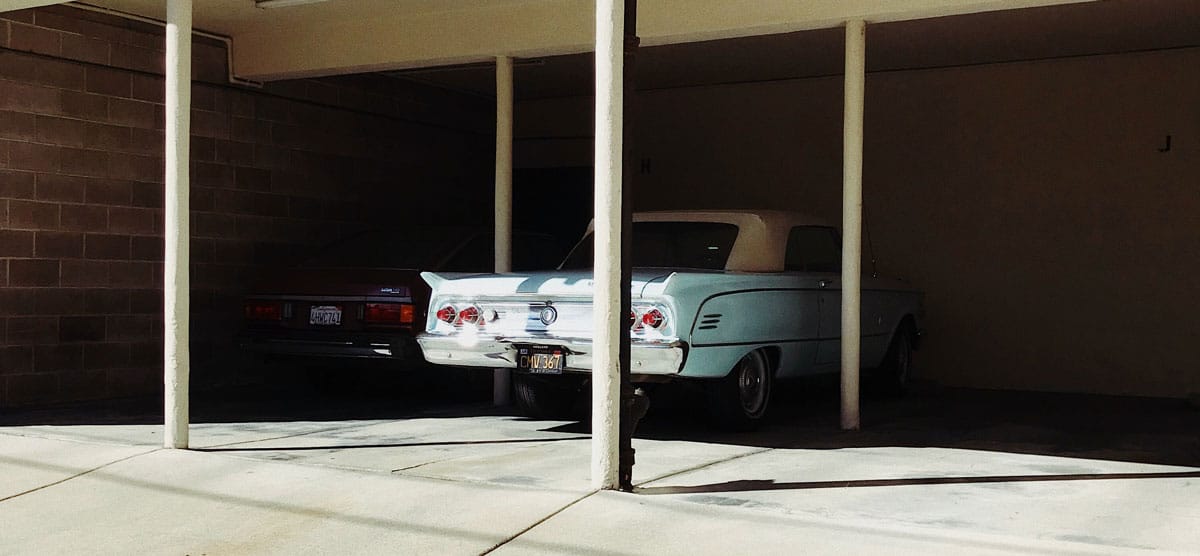Looking at storing a classic car for some time? Learn how storing a car the right way, from selecting a spot to keeping it in top shape while it sits, can protect your investment. Follow our tips to ensure your vehicle stays in peak condition, ready for the road when you are.

Key Takeaways
- Ensure proper preparation for long-term storage of a classic car, which includes choosing an ideal ventilated location and using climate-control options to protect from the elements and battery drainage.
- Perform a comprehensive cleaning and maintenance routine, pay attention to fluid levels, disconnect or maintain the battery charge, and choose the right car cover to prevent damage from dust, moisture, and pests.
- Upon retrieval from long-term storage, thoroughly inspect the car, maintain tire pressure to prevent flat spots, avoid using the parking brake to prevent brake pads fusion, and ensure all car-related paperwork like insurance and registration are up-to-date.
Table of Contents
Choosing the Ideal Location for Your Vehicle’s Hibernation
Securing the perfect location for your classic gem to rest is the initial step toward long-term car storage. Here are some options to consider:
- Climate-controlled storage facilities: These are optimal for keeping your car protected from the elements and prying eyes.
- Your own garage: If you have a garage, it can be a great option for storing your car. No garage? Read this.
- Public storage facility: If you don’t have a garage, consider renting a public storage facility.
- Neighbor’s garage: Services like Neighbor allow you to rent a neighbor’s garage, essentially the Airbnb of storage.
- Enclosed Car Trailer: You might have an enclosed car trailer that could be used for storage. While it’s not as good as climate-controlled storage, it can make due in a pinch.
Proper preparation for storage is necessary before letting your car sit for an extended vacation. A thorough wash and wax session is in order to protect the paint job from fading and discoloration. And if the car will be parked outdoors, a snug, weatherproof car cover is your best friend.
The chosen location should not only protect your car but also facilitate its smooth reawakening. Hence, a well-ventilated spot holds great importance. It helps preserve the life of the engine, preventing the dreaded dead battery scenario. If storing indoors, consider opening the car windows slightly or even investing in a dehumidifier.
Preparing Your Classic Car for Its Rest: The Essential Cleaning Regimen
A thorough cleaning should precede your car’s retreat into long-term hibernation. This isn’t mere cosmetic grooming. Cleaning your car, inside and out, is an essential step to prevent any debris from causing damage during the extended period of storage.
For the exterior, consider using gentle chenille microfiber or sheepskin mitts, and quality products like Mothers Gold Car Wash for the body and DUB by Maguire’s for the wheels. After the car is sparkly clean, apply a coat of wax to protect the paint job. This regimen will ensure your car’s fuel lines and other components remain in pristine condition.
The car’s interior warrants the same level of attention. Here are some areas to focus on:
- Steering wheel
- Dashboard
- Gear stick
- Door handles
Make sure these areas are clean and dry. It is also an opportune time to inspect the car battery, making sure it’s primed for long-term storage.

The Right Way to Cover Up: Selecting a Quality Car Cover
After tucking your car neatly in its storage spot, the next step is to wrap it up with care. A quality car cover is an investment worth making to keep your classic car protected from dust, moisture, and potential damage. Plus, it allows the much-needed air circulation around the car, including the exhaust pipe.
The ideal car cover material is a blend of polypropylene and polyester. These materials are:
- Effective against dust and moisture
- Breathable, allowing moisture to evaporate
- Prevent mold formation and dust accumulation on the car’s surface, including the fuel injection system.
While it might be tempting to use that old plastic tarp lying in your garage, resist the urge. Plastic tarps can trap moisture, leading to damage to the car’s paint over time.
Maintaining Fluid Levels and Preventing Contamination
Overlooking fluid levels is not an option when storing your car for an extended period. Changing the engine oil is a vital step. Fresh oil prevents moisture buildup in the oil reservoir and keeps your engine safe from contaminants present in used engine oil.
When preparing the fuel system for storage, fill the fuel tank to prevent moisture accumulation and limit condensation, avoiding the issues that come with an empty gas tank. Using a fuel stabilizer can protect the engine from gum, varnish, and rust due to ethanol buildup for up to 12 months.
Remember to check and maintain the levels of not just fuel and oil, but also coolant. Keeping these fluids at the correct levels helps protect your car during long periods of inactivity.
Battery Preservation Strategies During Extended Periods of Inactivity
The battery serves as the lifeline of your car. When the car is inactive for extended periods, the battery may eventually lose its charge. Prevent this by using a smart charger or disconnecting the negative battery cable.
Remember, even when parked, your car’s features like the anti-theft device, clock, and radio can drain the battery. Prevent this drainage by either disconnecting the negative cable or arranging for someone to drive the car intermittently, allowing the alternator to recharge the battery.
Before you disconnect the negative battery terminal, be aware that it will reset all electronic settings in the vehicle, such as radio presets and Bluetooth configuration. Ideally, start the car every week or two to maintain the battery’s charge.
Tire Care to Avoid Permanent Flat Spots
Another integral aspect of long-term car storage is tire care. Long periods of inactivity can lead to tire flat-spotting, where the weight of the car presses against the tire contact patch, causing it to become flat and rigid.
To prevent flat spots, follow these steps:
- Inflate the tires to the recommended pressure.
- Re-park the car every couple of weeks.
- For storage periods longer than a month, consider using jack stands to relieve pressure from the tires.
Remember to always check your car owner’s manual or seek advice from online forums to ensure your car can handle extended time on jack stands.

Navigating Braking Systems: To Engage or Not?
While the parking brake is friendly when parking on a slope, it may turn into a foe during long-term storage. Leaving the parking brake engaged for an extended period can cause the brake pads to fuse, posing a problem when the car is taken out of storage.
If you’re wondering how to keep the car in place without the parking brake, consider wheel chocks or tire stoppers. These can be securely positioned against the tire tread to prevent the car from moving.
Before you go ahead and use these alternatives, remember to use them properly. The chocks or stoppers should be securely positioned to prevent the car from moving during storage.
Safeguarding Against Unwanted Guests
When you store your car in storage, it may become a potential attraction for unwanted guests. Rodents and pests can cause significant damage to your car if they manage to infiltrate it.
Prevent this by sealing any gaps in the vehicle using caulk, weatherstripping, or wire. This will prevent the intrusion of dust, moisture, and pests into your classic car.
Besides sealing potential entry points, use deterrents such as mothballs or traps for added protection. Remember to inspect your classic car for signs of infestation at least once every month during the storage period.
Staying Road Ready: Keeping Up with Car Admin
Staying updated with all car-related paperwork is necessary during the storage period. Keeping up-to-date with your auto insurance, even during storage, is advisable. There are insurance options tailored for long-term storage like comprehensive coverage policies, which protect against damages caused by factors other than collisions.
Lastly, don’t forget to manage your car registration during storage. Neglecting car paperwork could lead to potential issues like expired registration or lapses in insurance coverage when returning the car to the road.

Starting Your Car Post-Storage
It’s time to awaken your classic beauty from its hibernation. A comprehensive inspection is vital to ensure that your car is free of damage, and all fluid levels are appropriate.
A test drive is also in order at this time. This short ride will help you ensure that everything is operating as it should.
Remember, only when all inspections and test drives confirm that the car is functioning smoothly without issues should you fully integrate it back into regular usage.
Summary
In conclusion, storing a classic car for the long term is not just about finding a convenient spot and covering it up. It involves meticulous cleaning, careful fluid management, preserving the battery, taking care of the tires, and managing car paperwork. But the effort is worth it when you see your classic beauty in perfect shape, ready to hit the road again. So, take these steps to heart, and your classic car will thank you by providing many more years of joy and memories.
Frequently Asked Questions
How long can you store a car without driving it?
You can store a car without driving it for about two to three weeks without major issues. However, leaving it unattended for more than two weeks may lead to technical difficulties, and after six months, it may cause severe and potentially irreparable damage to the engine.
If you’re going to store your car for a long period of time, make sure you do the prep work to ensure it starts when you uncover it from its nap.
Is it better to store a car with a full or empty tank?
It is better to store a car with a full tank of gas to prevent internal rust caused by condensation and moisture. An empty or low gas tank can lead to this issue.
How do I prepare my car for storage for years?
To prepare your car for long-term storage, clean it inside and out, fill the gas tank, change the oil, check for leaks, and keep the battery charged to avoid any issues when you’re ready to drive it again.
Can I leave my car unused for 3 months?
No, it’s not ideal to leave a car unused for 3 months. If possible, start and drive the vehicle for about 10 miles a couple of times per month to keep it in good condition.
How do I prevent my car’s battery from draining during long-term storage?
To prevent your car’s battery from draining during long-term storage, Get Vintage Vehicles suggests using a smart charger. Taking this step will help ensure your battery stays in good condition.



